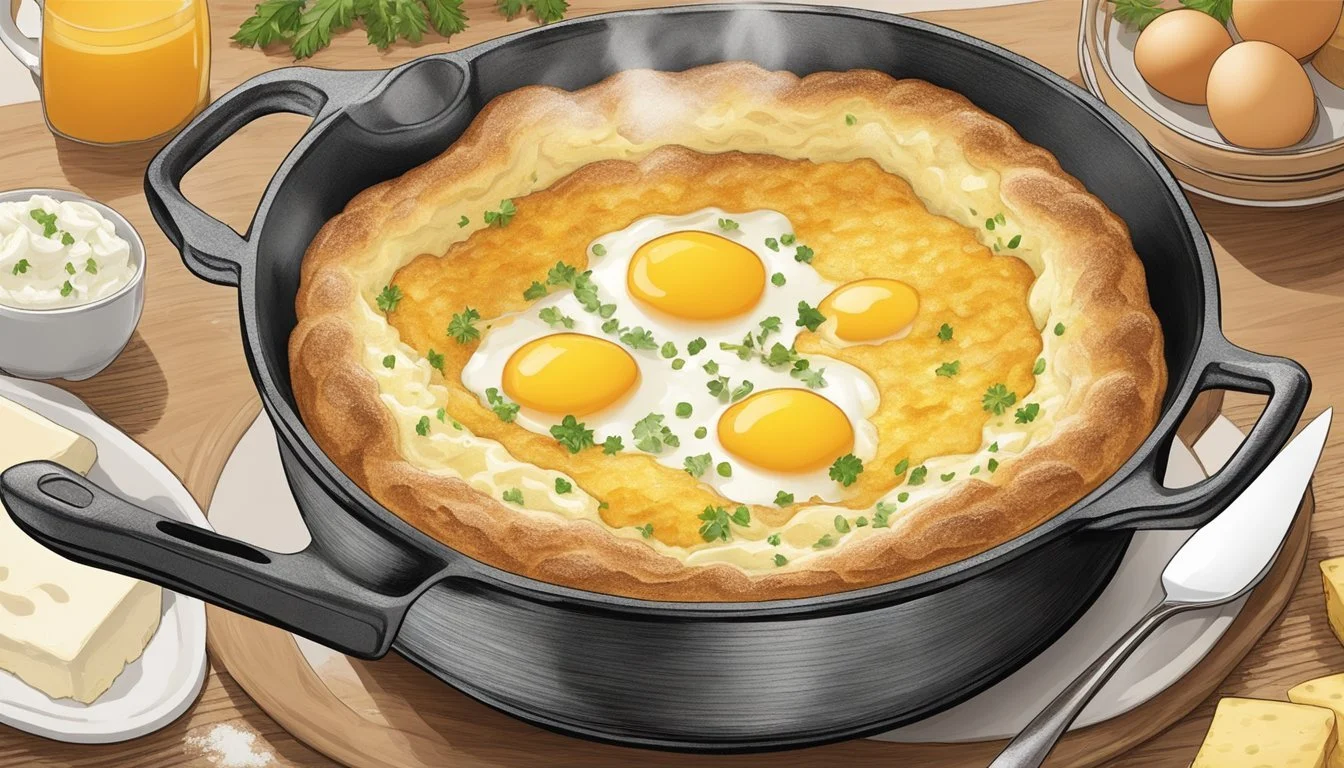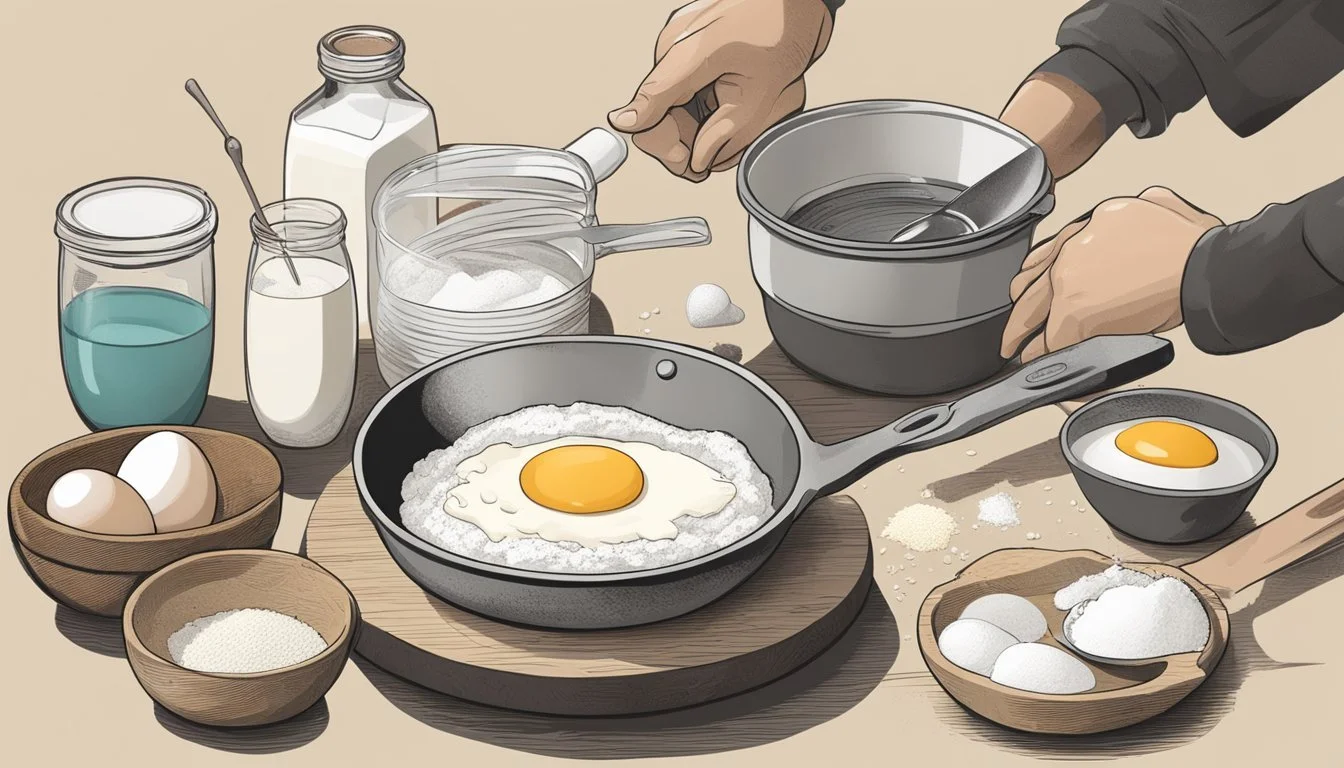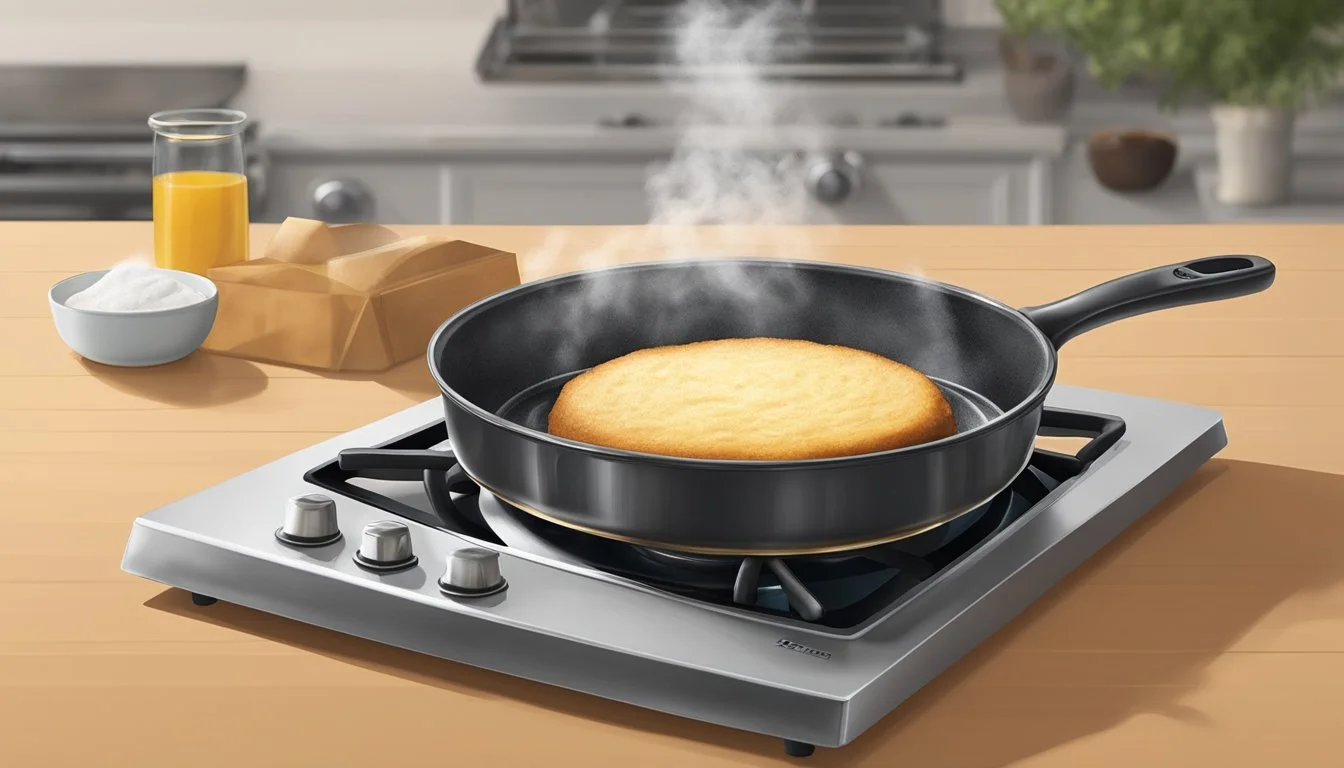The Skillet Soufflé
Mastering Stovetop Elevation in Culinary Arts
The skillet soufflé is an innovative take on the classic French dish that typically requires precise baking techniques and a vigilant eye on the oven. This stovetop method simplifies the process, allowing the delicate entrée or dessert to come to life in less time and with less stress. Perfect for cooks who may not have access to an oven or those seeking a quicker alternative, the skillet approach uses the steady heat of the stovetop to create a fluffy and airy soufflé without compromising on the traditional texture or taste.
Creating a soufflé in a skillet begins with a stable base, often a Swiss meringue, which is known for its robustness compared to its uncooked counterpart. The meringue is then gently folded into a flavored base - be it cheese for a savory option or chocolate for a sweet indulgence. The key lies in maintaining the aeration of the whisked eggs, ensuring the final product can rise effectively. Cooking it in a skillet over moderate heat allows for a more controlled environment, reducing the risks of the dramatic rise and fall associated with oven-baked soufflés.
The beauty of this skillet soufflé recipe is its versatility. Suitable for breakfast, brunch (What wine goes well with brunch?), or dessert, it can be adapted to cater to a variety of taste preferences and occasions. Moreover, it requires minimal kitchen equipment – a single skillet and a few standard kitchen tools. This method makes the luxurious soufflé accessible to many, proving that with the right technique, achieving a perfect rise isn't confined to professional kitchens and doesn't require complex appliances.
The Essentials of Soufflé Preparation
Preparing a soufflé requires careful attention to detail and technique. Here's a concise guideline for aspiring chefs to achieve soufflé success:
Ingredient Temperature
Egg whites and yolks should be at room temperature to ensure proper volume when whipped.
Sugar and salt are integral: sugar helps to stabilize the egg whites, while salt enhances flavor.
Mixing Technique
When combining yolks and other ingredients into a mixture, use a spatula to fold gently, preserving air.
Egg whites must be whipped to the right stage—soft peaks are crucial; stiff yet not dry or granular.
Utensils and Tools
Use clean, grease-free utensils. Any residue can inhibit the egg whites from expanding.
A whisk is key for whipping egg whites, and a spatula for folding without deflating the mixture.
Proportion is paramount. The stability of the mixture hinges on the precise balance between egg whites and base ingredients.
Item | Purpose
--- | --- Egg Whites | Provide structure and lift. Egg Yolks | Add richness and color. Sugar | Stabilizes the whites' foam. Salt | Enhances overall flavor. Whisk | Incorporates air into egg whites. Spatula | Folds ingredients carefully to retain air.
In summary, a successful skillet soufflé relies on the mastery of these essentials—temperature, technique, and the harmony of ingredients with proper tool usage.
Tools and Techniques
Selecting the appropriate tools and mastering specific techniques is crucial to crafting a light and fluffy skillet soufflé. This process includes everything from picking the right skillet to timing the cooking process with precision.
Choosing the Right Skillet
The foundation of a successful skillet soufflé starts with an 8 to 10-inch nonstick skillet that's oven-safe if the stovetop method isn't used. It should be buttered generously to prevent sticking, enhancing the golden texture of the finished soufflé.
Whisking to Perfection
Using an electric mixer set at medium speed, beat egg whites until they form stiff peaks. The peaks should stand upright without drooping. A foamy, glossy mixture indicates that air has been properly incorporated for optimal rise.
Incorporating Ingredients for Optimal Fluffiness
Gentle folding is key when combining the yolk-based mixture with whipped egg whites. Perform this action with a spatula, using consistent, smooth motions to maintain a light texture without deflating the mixture.
Oven Alternatives: Skillet Cooking Method
For those without an oven, preheat the skillet on the stove over medium heat. Once the batter is poured in, cover it and allow it to cook, monitoring the heat to make sure it is consistent for even cooking.
Timing and Temperature Control
Whether using an oven or stovetop, accurate timing and temperature control are imperative. On the stove, cook the soufflé until it's golden and set. If using an oven, preheat it to 325°F before baking, and carefully monitor to avoid overcooking.
Garnishing and Serving Techniques
Serve the soufflé immediately to maintain its airy texture. Garnish it with a light dusting of powdered sugar or fresh fruit for both taste and presentation, ensuring each serving delivers the wow factor.
Ingredient Selection and Substitutions
Selecting the right ingredients and knowing how to substitute them effectively is crucial for creating a successful skillet soufflé. Whether addressing dietary needs or taste preferences, understanding these essentials is key for both novice and experienced cooks.
Essential Soufflé Ingredients
A skillet soufflé's foundation rests on a few staple ingredients:
Eggs: Separated into whites and yolks, they provide structure and richness.
Flour: Typically all-purpose flour is used for its gluten content, which helps in stabilizing the soufflé.
Milk: Full-fat milk is preferred for moisture and flavor.
Sugar: Necessary for sweetness in dessert soufflés.
Fat: Butter is often used to add flavor and assist the rise by coating the cooking vessel.
Salt: Enhances the overall flavor profile.
Sweet and Savory Variations
Sweet or savory, soufflés are versatile. Here are common additions for each type:
Sweet Soufflés:
Chocolate or vanilla for flavor.
Cheese, such as grated Gruyère, for a savory twist.
Savory Soufflés:
Cheese or herbs for flavor.
Incorporating components like smoked salmon or spinach can add depth.
Finding Alternatives for Common Allergens
It's important to offer substitutions for allergens:
Dairy-Free Options:
Milk can be substituted with almond, soy, or oat milk.
Dairy-free butter alternatives for fat content.
Gluten-Free Alternatives:
A one-to-one gluten-free flour blend can replace all-purpose flour.
Be sure to check for xanthan gum in the mix, which helps mimic gluten's elasticity.
Quality of Ingredients
The quality of ingredients directly influences the taste and texture of the soufflé:
Freshness: Fresh, organic eggs often offer better structure for egg whites and yolks.
Organic: Choosing organic milk and butter can improve flavor and align with farm-to-table values.
Chocolate and Vanilla: High-quality chocolate and pure vanilla extract yield a more pronounced taste.
.MouseEventHandler is essential for selecting the right ingredients and making substitutions that will lead to a successful skillet soufflé. Fresh, organic products typically provide better results, and finding replacements for milk and flour can cater to those with dietary restrictions without compromising the dish.
Advanced Soufflé Techniques
Advanced techniques in soufflé preparation elevate this delicate dish to new heights. Focusing on the intricacies of meringue types, methods to ensure a perfect rise, and strategies to prevent deflation will arm any cook with the prowess to excel in soufflé baking.
Mastering Meringue Types
Meringue is foundational to the soufflé's structure. French meringue, prepared by beating sugar into egg whites until soft peaks form, offers a lighter texture but less stability. In contrast, Swiss meringue stands out for its durability, crafted by whisking egg whites and sugar over a double boiler before reaching stiff peaks through beating. Whichever choice one makes, consistency is key—the meringue must be smooth, glossy, and free of sugar grains.
Achieving the Perfect Rise
The rise of a soufflé is a testament to one's baking prowess. It is essential to preheat the oven to the correct temperature as fluctuating heat can affect the rise. Incorporating a small amount of baking powder can also assist in achieving that coveted lift. When folding in the meringue, a gentle hand ensures that air is not knocked out, preserving the egg whites' integrity and promoting an even ascent during baking.
Preventing Soufflé from Deflating
Deflation can spell disaster for a soufflé's presentation. To prevent this, ensure that the oven door remains closed throughout the cooking process to maintain a consistent temperature. Additionally, serving immediately after baking captures the soufflé at its peak. A stable meringue, such as a Swiss variant, will also aid in maintaining the soufflé's structure long enough to impress at the dining table.
The Science of Soufflés
A soufflé, at its core, is a culinary marvel that showcases the delicate interplay between protein structure and thermal expansion. The process begins with two main components: a flavorful base that often contains fat—such as egg yolks mixed with a sauce like béchamel—and a fluffy meringue made from egg whites.
Egg whites are pivotal to a soufflé’s structure. Whisking these whites incorporates air bubbles, which are stabilized by protein networks. These proteins unfurl and bond during whisking, creating a foam that traps the air. To further stabilize the foam and hold the air bubbles, an acid like cream of tartar can be added. This ensures that the bubbles don't collapse too easily, aiding the soufflé in achieving its signature rise.
Emulsification is another crucial process. The mixing of fats from the yolks into the base without disrupting the airy meringue requires careful folding. Overmixing can cause deflation, as it breaks down those crucial air pockets.
Upon heating, the expansion comes into play. The trapped air bubbles in the egg whites expand due to the increase in temperature, which causes the soufflé to rise. The egg proteins then coagulate and set, holding the soufflé's shape. Ensuring a steady temperature is key, as fluctuations can affect how the air bubbles expand and can lead to uneven rising or the dreaded collapse.
A skillet soufflé simplifies the traditional baking process by eliminating the need for an oven, yet it retains the science of its oven-baked counterpart. By managing heat on the stovetop, one can still achieve the desirable airy texture and height that makes a soufflé spectacular.
Dish Pairing and Occasion
Skillet soufflés present a versatile option for any meal, whether a person seeks a sweet touch to brunch or an elegant dessert. The following pairings are selected to complement the dish's texture and flavors, enhancing the dining experience for various occasions and dietary preferences.
Brunch Bliss: Soufflé Pancakes
For breakfast or brunch, soufflé pancakes offer a fluffy, light alternative to traditional pancakes. They incorporate whipped egg whites for that extra rise, making them a popular choice. A person can enhance these pillows of joy with a drizzle of maple syrup, a sprinkle of powdered sugar, or a dollop of whipped cream. For a citrus twist, adding a few drops of lemon juice can brighten the flavors. These pancakes pair well with a hot cup of tea or coffee, rounding out a perfect brunch gathering.
Dessert Decadence: The Classic Soufflé
The classic soufflé stands as an iconic dessert, often flavored with chocolate, vanilla, or fruit purées. A person could serve these airy confections straight from the skillet with a scoop of ice cream on the side for a contrasting temperature and texture. They are best enjoyed immediately after baking, when the height is at its peak and the interior is still delightfully creamy. The choice of a darker chocolate or a vibrant fruit like raspberry will depend on the sweetness preference and occasion.
Catering to Dietary Restrictions
Offering soufflé options that cater to gluten-free, dairy-free, vegetarian, or vegan diets is not only considerate but also necessary in the modern culinary world. A person can easily substitute traditional ingredients with alternatives like almond milk or aquafaba (the liquid from canned chickpeas). During afternoon tea, a mini soufflé with dairy-free chocolate or a vegan fruit variant is a luxurious addition that accommodates diverse dietary needs without compromising on taste or presentation.
Troubleshooting Common Soufflé Issues
When making a skillet soufflé, cooks may encounter various challenges such as deflating, weeping, undesired texture, lack of firmness, or splitting. The following tips can help resolve these issues to achieve a well-risen, delectable soufflé.
Deflating:
Ensure gentle folding of egg whites into the base to maintain airiness.
Avoid opening the skillet lid frequently, as temperature fluctuations can cause collapse.
Weeping (Liquid Separation):
Stabilize the base with a proper roux to prevent moisture from leaking out.
Cook the soufflé at a consistent heat; variable temperatures can lead to weeping.
Texture Problems:
For a lighter texture, egg whites should reach stiff peaks but not be overbeaten.
If the soufflé is too dense, make sure the base is not too thick before folding in the egg whites.
Firmness:
The skillet should be adequately preheated to ensure the soufflé starts cooking immediately.
A well-buttered and coated pan helps the soufflé climb up the sides, increasing firmness.
Splitting:
Uniform folding is key; uneven folding can cause the mixture to separate.
Avoid under or overcooking, as both can lead to the layers splitting.
Table 1: Checklist for Skillet Soufflé Perfection
Issue Diagnostic Solution Deflating Opens lid often, rough handling Gentle folding, stable temperature Weeping Inconsistent baking, weak base Stable heat, firm roux Texture Overbeaten egg whites, thick base Stiff peaks, balanced base mixture Firmness Cold skillet, improper preparation Preheat skillet, butter and coat pan Splitting Uneven folding, improper cooking times Even folding, precise cooking duration
By adhering to these guidelines with confidence and a clear understanding, one can successfully address common issues that arise when preparing a skillet soufflé.
Culinary Tips and Presentation Tricks
When creating a skillet soufflé, presentation is key to enhancing the overall dining experience. Achieving a golden exterior gives the soufflé visual appeal, which one can accomplish by preheating the skillet and monitoring the cook time carefully.
Preheat your skillet to ensure even cooking.
Aim for a golden color, indicating readiness.
Sprinkling powdered sugar atop the soufflé adds a touch of elegance and sweetness. Using a sieve ensures an even distribution without clumping.
Sift powdered sugar for a snowy effect.
Do this just before serving to maintain texture.
Incorporating fruit not only adds a burst of flavor but also introduces vibrant colors to the presentation. A variety of fruits can complement the delicate flavors of the soufflé.
Colorful fruit enhances appeal.
Serve fruit on the side or as a topping.
Presentation tricks such as a dollop of cream or a drizzle of sauce can accentuate the soufflé without overpowering it. A minimalist approach reinforces the confidence in the dish's inherent qualities.
Use sauces sparingly for a hint of complexity.
Cream adds a luxurious finish.
The skillet soufflé shines when its glossy peak stands tall. Serving immediately is crucial to preserve the lift and temperature of the dish.
Serve soufflés promptly after cooking.
A glossy peak suggests perfect texture.
By paying attention to these culinary tips and presentation tricks, chefs ensure that the skillet soufflé is not only a delight to taste but also a feast for the eyes.
Health and Nutrition Information
A skillet soufflé provides a tempting option for those looking for a warm, fluffy dish without the need for an oven. When focusing on health and nutrition, it's helpful to break down the key components of a typical skillet soufflé.
Calories: The total calories in a skillet soufflé can vary widely depending on the ingredients used. A basic recipe may contain between 200 to 300 calories per serving.
Fat: Eggs, often a primary ingredient in soufflés, contain saturated fats. While some recipes use butter, opting for cooking spray can reduce the fat content.
Sodium: Soufflés can contain moderate amounts of sodium, particularly if cheese or salt is added for flavor. It's essential to monitor this, especially for individuals with sodium-sensitive conditions.
Carbohydrates: Flour is a common thickener in soufflés, contributing to the carbohydrate content. Alternatives like almond flour can be used for a lower-carb option.
Nutrient Approximate Amount Per Serving Fiber 1-2g Protein 6-12g Saturated Fat 2-5g
Fiber: Ingredients like spinach add fiber, enhancing the nutritional profile of the soufflé.
Protein: Eggs are an excellent source of protein, making the soufflé a potentially protein-rich dish.
Finally, one must consider the balance of nutritional values, making ingredient adjustments as necessary for individual dietary needs. Approaching the skillet soufflé with these health and nutrition factors in mind can aid in enjoying the dish as part of a balanced diet.
Concluding Thoughts
A skillet soufflé is a testament to the ingenuity of home cooks seeking to bypass traditional methods. This approach simplifies the process, making it accessible and less intimidating for many. It is crucial to remember that, although it may seem challenging at first, mastery is attainable with a bit of practice. To achieve the desired fluffiness and height, one must pay close attention to the consistency of the egg whites and the stability of the Swiss meringue.
Preparation: Ensuring the skillet is well-buttered and sugared helps the soufflé to climb its sides and achieve the characteristic rise.
Temperature: A consistent and suitable oven temperature, often around 325°F, is vital for even cooking.
The skillet soufflé marries convenience with the delight of sophisticated desserts. One can adorn it with various toppings, from simple salted butter to more elaborate garnishes, tailoring it to individual taste buds and occasions.
One should not be discouraged by the potential for mishaps. Whether it's a soufflé that doesn't puff to the heavens or an unintended texture, each attempt is a step closer to perfection. A skillet soufflé, with its less than 20-minute prep time, demonstrates that a classic French dish can evolve into a stress-free and enjoyable cooking experience.










